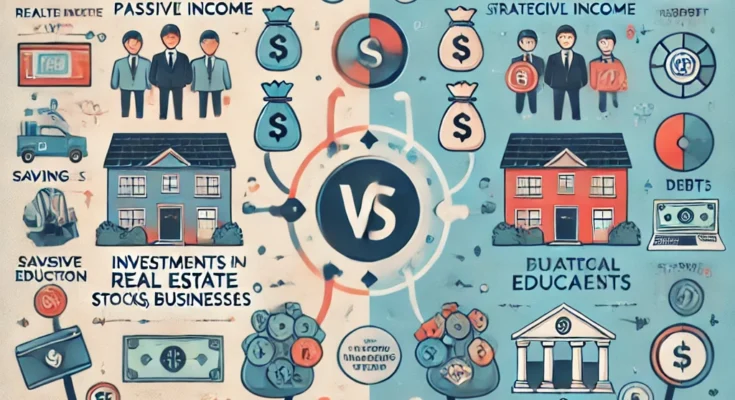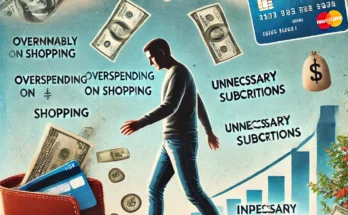Why do the rich keep getting richer while the middle class struggles to break free from financial stagnation? The answer lies in financial habits, investment strategies, and the fundamental mindset toward wealth creation. The wealthy leverage assets, financial literacy, and networking opportunities to build lasting prosperity. Meanwhile, the middle class often finds itself trapped in a cycle of earned income, debt, and limited financial knowledge.
This article explores the five key reasons why the rich continue to amass wealth while the middle class remains financially stuck. By understanding these principles, anyone can take steps toward financial growth and break free from limiting financial patterns.
1. Wealthy Individuals Invest, While the Middle Class Saves
How the Rich Approach Money
Wealthy individuals understand that money should work for them. Instead of letting their savings sit in low-interest bank accounts, they actively invest in:
- Stocks and Bonds: They capitalize on compound interest and stock market appreciation.
- Real Estate: Rental properties and commercial real estate provide passive income and asset appreciation.
- Businesses: Owning and investing in businesses creates multiple revenue streams.
- Alternative Investments: Crypto, private equity, and hedge funds are common wealth-building strategies.
How the Middle Class Handles Money
Many middle-class individuals rely heavily on savings accounts, which barely keep up with inflation. While saving is essential, solely relying on it leads to financial stagnation. Fear of risk and a lack of financial education prevent many from entering the investment world, ultimately widening the wealth gap.
Solution:
- Start by investing in index funds or ETFs with low risk.
- Build a diversified portfolio with real estate, stocks, and mutual funds.
- Develop a long-term investment strategy rather than hoarding cash.
2. The Rich Focus on Asset Accumulation, While the Middle Class Relies on Active Income
How the Rich Build Wealth
The wealthy prioritize acquiring assets that generate continuous income and appreciate over time. They focus on:
- Income-producing assets such as rental properties, dividend-paying stocks, and intellectual property.
- Business ownership to create financial independence.
- Automation and delegation to free up time while maintaining earnings.
The Middle-Class Trap
Most middle-class individuals earn money through salaries or wages. Since their income is dependent on working hours, there’s a limit to how much they can earn. Without passive income sources, they struggle to build wealth beyond their paycheck.
Solution:
- Invest in assets that provide passive income.
- Look for side businesses that can generate revenue without constant effort.
- Reduce reliance on a single income source.
3. The Wealthy Leverage Debt to Grow Wealth, While the Middle Class Uses Debt for Consumption
How the Rich Use Debt Wisely
The wealthy understand the difference between good debt and bad debt:
- Good debt: Mortgage loans on rental properties, business loans, and investment leverage to create long-term wealth.
- Bad debt: Credit cards, high-interest loans, and unnecessary liabilities that depreciate over time.
By using debt strategically, they acquire more income-generating assets and scale their investments.
How the Middle Class Misuses Debt
Many middle-class individuals take on debt for non-appreciating assets like:
- Cars
- Luxury items
- Credit card spending for consumer goods
These expenses drain wealth instead of growing it.
Solution:
- Use debt to acquire appreciating assets.
- Avoid high-interest loans for unnecessary purchases.
- Focus on paying off bad debt while leveraging good debt.
4. The Wealthy Prioritize Financial Education, While the Middle Class Relies on Traditional Schooling
The Rich Continuously Learn About Wealth
Financial literacy is a priority for the wealthy. They educate themselves through:
- Books, podcasts, and seminars on investing and entrepreneurship.
- Networking with successful investors and mentors.
- Hiring financial advisors to optimize wealth strategies.
The Middle Class and Traditional Education
Many middle-class individuals believe that a formal education and a stable job are enough for financial success. However, schools rarely teach financial literacy, leaving many unaware of how to build wealth effectively.
Solution:
- Read books on finance and investing (e.g., Rich Dad Poor Dad).
- Follow financial experts and attend wealth-building seminars.
- Continuously improve financial knowledge and apply learned strategies.
5. The Rich Build Powerful Networks, While the Middle Class Operates in Isolation
How the Rich Leverage Networks
The wealthy understand the power of relationships in wealth-building. They:
- Associate with successful entrepreneurs and investors.
- Gain access to exclusive investment opportunities.
- Benefit from mentorship and insider knowledge.
The Middle Class and Social Circles
Many middle-class individuals interact with people of similar financial status. Without exposure to high-level financial discussions, their financial growth remains limited.
Solution:
- Join business and investment communities.
- Attend networking events and connect with successful individuals.
- Seek mentorship from financially successful people.
Conclusion: Breaking Free from Financial Stagnation
The gap between the rich and the middle class is largely due to differences in financial habits, education, and mindset. The good news is that anyone can adopt the wealth-building strategies of the rich by:
- Investing rather than just saving.
- Acquiring income-generating assets.
- Using debt strategically for wealth creation.
- Continuously improving financial education.
- Expanding networks and learning from successful individuals.
By making these shifts, anyone can move toward financial freedom and break free from the cycle of financial stagnation.
Final Thoughts
The rich aren’t just lucky; they follow specific wealth-building principles that keep them ahead. If you start applying these strategies today, you can change your financial future and create long-term prosperity. Are you ready to break free from financial stagnation? Start now by taking the first step toward smarter financial decisions!




